|
FAQs about Mussid Coral
Trauma
FAQs on Mussid
Disease:
Mussid Disease 1, Mussid Health 2, Mussid Disease 3, Mussid Disease 4,
Mussid Disease 5,
FAQs on Mussid Disease by Category:
Diagnosing,
Environmental (Pollution/Poisoning, Lighting...),
Nutritional,
Social (Allelopathy),
Pathogenic (Infectious, Parasitic, Viral)
Predatory/Pest,
Treatments
Related Articles: Coral Pests and Disease; pests, predators,
diseases and conditions by Sara Mavinkurve, Mussid Corals,
FAQs on Stony Coral Disease: Stony Coral Disease 1, Stony Coral Disease 2, Stony Coral Disease 3, Stony Coral Disease 4, Stony Coral Disease 5, Stony Coral Disease 6, Stony Coral Disease 7, Stony Coral Disease 8, Stony Coral Disease 9, Stony Coral Disease 10, Stony Coral Disease 11, Stony Coral Disease
12, Stony Coral Disease 13,
Stony Coral Disease 14,
Stony Coral Disease 15, Stony Coral
Disease ,
FAQs on Stony Coral Disease by Category: Diagnosing:
Environmental (Pollution/Poisoning, Lighting...),
Nutritional, Social (Allelopathy),
Trauma,
Pathogenic (Infectious, Parasitic, Viral)
Predatory/Pest,
Treatments
FAQs on Stony Coral Disease by Family: Acroporid Disease, Acroporid Disease 2, Acroporid Disease 3, Acroporid Disease 4..., Caryophyllid Disease, Caryophyllid Disease 2..., Elegance Coral Disease/Pests, Dendrophylliid Disease, Faviid Disease, Faviid Disease 2, Fungiid Disease,
Mussid Health 2, Poritid Health, Trachyphylliid Disease, Trachyphyllia Disease 2,
FAQs on Stony Coral Disease by Type: Brown Jelly Disease, RTN,
|
|
|
Acanthastrea having issues 2/17/10
Hi Crew,
<Vic>
Long ago in another lifetime you answered some questions about a
freshwater setup that I had at the time- thanks for that and for
all the advice you give your readers. I always recommend this
site to my friends and new people in the hobby.
I've since graduated to reefkeeping. I currently have a 29
gallon biocube which I have modified in several ways. It has a
Nano-Doc skimmer, filter floss, a Koralia-1, and two return pumps
instead of one. I haven't upgraded
the stock lighting (but I am planning an LED retrofit project).
I've installed a homemade media basket strongly lit on a
reverse day cycle in which I am growing Chaetomorpha for nutrient
export. I feed fish a small amount of Spectrum pellets every day,
and try to feed the corals frozen Mysis or brine shrimp once
every 2-3 days, and all of the other animals take
part in the feeding.
I have a couple questions and one in particular (about my Acans)
that I was hoping you could answer. First, the usual preliminary
info...
Current inhabitants:
2x juvenile black Ocellaris clowns
Acanthastrea sp. <-- this is the coral in question
Several Zoanthids
Pachyclavularia violacea
Dendrophyllia fistula (not sure if this is the exact species...
"real"
Dendros, not sun coral)
Ricordea florida
Euphyllia divisa
Lobophyllia sp. (red border, turquoise center)
Sarcophyton (neon green)
Seriatopora hystrix (hyacinth)
Seriatopora guttata (green)
Montipora capricornis (orange)
Euphyllia glabrescens
Duncanopsammia axifuga
Cyphastrea ocellina
Clavularia sp. (purple snowflake cloves)
Xenia umbellata
Favia sp. (Christmas Favia)
Montipora digitata
Ricordea yuma
<... all this in a 29 gal. cube?!>
4x Thor amboinensis sexy shrimp
1x Red skunk cleaner shrimp
2x Bumblebee snails
3x Mexican turbo snails
6x Cerith snails
4x Nassarius snails
That sounds like a lot now that I listed it all out but they are
mostly smaller frags of a few heads or branches. The tank has
been set up for several months. I'm pretty OCD about it and I
feel that while stocking may appear to be heavy for a tank this
young, I added each coral individually and kept tabs on the water
parameters the whole time, with religious 5gal/week water changes
(or more). I also change my filter floss every other day, as soon
as it turns light brown.
<Okay>
Water parameters are all within acceptable levels. Last
checked:
ph : 8.3
Ca : 390 ppm
dKH : 9.5
PO4 : 0 - .25 ppm
NO3 : 5 ppm (did a few water changes after this reading)
sg : .023
<Mmm, I'd raise this and keep in steady at 1.025>
temp : ~79
With the exception of my Acans which have been very healthy
looking up till now, all of the corals are doing well. They are
all growing- even the birdsnest and Montis both of which are usually recommended for systems
with more light than the PC bulbs in my stock hood. I have them
up high in the center of the tank where the PAR is highest, with
good results. I haven't seen any signs of stress or disease
on any other corals in the tank and have yet to lose a single
animal so far.
When I got the Acans they had been fragged a couple weeks earlier
and were still recovering from that- some of the heads were only
partial and the skeleton was visible on all sides. In the few
months I had them, they have fully recovered and all of them had
essentially regrown the full circle of their outer flesh.
<Only the first pic "came through" and it looks very
nice indeed. Oh, got the second one to "save"... it
looks fine as well>
I have a couple beautiful shots of them at this stage. A few days
ago I noticed a sexy shrimp sitting on the inner disc of one of
the Acan heads picking at a whitish looking thing that looked
like it was stuck in or coming out of the mouth of the polyp.
<Mmmm... summat going on here>
I wasn't sure what it was but thought it might be some sort
of waste, having seen these shrimp eat Lobophyllia poop many
times. I saw it the next day in the same spot and the coral was
clearly in some kind of distress- or at least did not appear
normal at all. This white thing, I discovered, was actually a bit
of skeleton. I'm not sure if it was always there and just
right below the surface of the polyp but I hadn't seen the
skeleton in that spot before. A couple days later the issue had
progressed and the edge of the Acan was developing some kind of
tear or recession. The other heads on the colony and even the
other side of the affected polyp appear to be doing alright- an
adjacent polyp does look like its having a similar thing happen
on its outer flesh ring, though, and I'll keep an eye on
it.
<Good>
I've attached a picture of the same coral eating some Mysis
while healthy a few weeks ago, and another one that I took last
night with my phone - please excuse the graininess.
Any idea what this could be?
Bacterial infection?
Some parameter that would only affect the Acan?
Is this some weird type of polyp reproduction/splitting?
Damage from sexy shrimp picking at it?
<Maybe one of these or another possibility... one of the
clowns or another invertebrate chewing>
On this note, I have seen them 'picking' at corals before
including this Acan, my Seriaptora, and even saw them rolling
around a Zoanthid that had either come off on its own from a
fresh frag or was "removed" for a sexy shrimp feast.
It's annoying but I try to keep them well fed to curb these
impulses. They mainly hang out on the Lobophyllia which does not
seem to mind their presence, but I frequently see them reaching
down into a mouth with their evil little pincers.
<These little Thor are generally not problematical... are more
opportunistic by far than predaceous>
It may or may not be related- my Ocellaris clowns were recently
introduced to the tank a week or two ago after two months in a
hospital/quarantine tank to guarantee that I did not have any
marine Ich. In the last five days, one of them has developed a
moderate fin rot on the front of its dorsal fin.
I'm not sure what could have caused it.
<Maybe rubbing against the Acanthastrea>
They don't look stressed, there are no other aggressors in
the tank, and the water checks out. Both are eating and have
ravenous appetites. They have been trying to host in my torch
coral.
maybe they hurt themselves on the skeleton somehow?
<Yes; easily so>
I am moving them to my hospital tank and treating with Maracyn 2
starting tonight,
<Mmm, I wouldn't be moving so fast here... unless
they're in obvious trouble, I'd leave them where they
are>
but it's disheartening to have them get sick all of a sudden
with no obvious cause.
Any ideas on the fin rot?
<Interaction with...>
How long should I have them in the hospital tank before returning
them to the main tank for this treatment? I am fairly certain
that at this point with some of the dorsal fin bones exposed,
treatment is absolutely necessary and the fish will not recover
without medication... correct me if I'm wrong.
Thanks for reading and for any advice that you can give.
Victor
<Welcome. Bob Fenner>
|
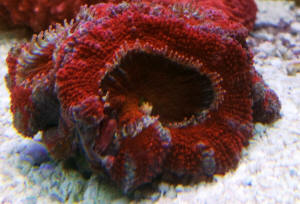 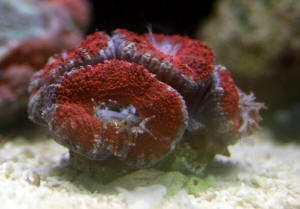 |
|
Re: Acanthastrea having issues
2/17/10
Comments/further questions added inline. Thanks for the response
Bob!
> Hi Crew,
> <Vic>
> Long ago in another lifetime you answered some questions
about a freshwater
> setup that I had at the time- thanks for that and for all
the advice you
> give your readers. I always recommend this site to my
friends and new people
> in the hobby.
> I've since graduated to reefkeeping. I currently have a
29 gallon biocube
> which I have modified in several ways. It has a Nano-Doc
skimmer, filter
> floss, a Koralia-1, and two return pumps instead of one. I
haven't upgraded
> the stock lighting (but I am planning an LED retrofit
project). I've
> installed a homemade media basket strongly lit on a reverse
day cycle in
> which I am growing Chaetomorpha for nutrient export. I feed
fish a small
> amount of Spectrum pellets every day, and try to feed the
corals frozen
> Mysis or brine shrimp once every 2-3 days, and all of the
other animals take part in the feeding.
> I have a couple questions and one in particular (about my
Acans) that I was
> hoping you could answer. First, the usual preliminary
info...
> Current inhabitants:
> 2x juvenile black Ocellaris clowns
> Acanthastrea sp. <-- this is the coral in question
> Several Zoanthids
> Pachyclavularia violacea
> Dendrophyllia fistula (not sure if this is the exact
species... "real"
> Dendros, not sun coral)
> Ricordea florida
> Euphyllia divisa
> Lobophyllia sp. (red border, turquoise center)
> Sarcophyton (neon green)
> Seriatopora hystrix (hyacinth)
> Seriatopora guttatus (green)
> Montipora capricornis (orange)
> Euphyllia glabrescens
> Duncanopsammia axifuga
> Cyphastrea ocellina
> Clavularia sp. (purple snowflake cloves)
> Xenia umbellata
> Favia sp. (Christmas Favia)
> Montipora digitata
> Ricordea yuma
> <... all this in a 29 gal. cube?!>
Yes, it sounds like a lot but if you saw a picture I'm sure
it would seem a lot more realistic. They're all very small
specimens. With proper water changes and placement, aggressive
skimming, etc I think it'll be ok.
<<Ah yes. I have seen very much more involved/stocked small
systems...
All's fine as long as folks do as you state you have done...
start w/ small specimens, acclimate them properly... TILL the
colonies all get larger, begin to impinge on each
other.>>
> 4x Thor amboinensis sexy shrimp
> 1x Red skunk cleaner shrimp
> 2x Bumblebee snails
> 3x Mexican turbo snails
> 6x Cerith snails
> 4x Nassarius snails
> That sounds like a lot now that I listed it all out but they
are mostly
> smaller frags of a few heads or branches. The tank has been
set up for
> several months. I'm pretty OCD about it and I feel that
while stocking may
> appear to be heavy for a tank this young, I added each coral
individually
> and kept tabs on the water parameters the whole time, with
religious
> 5gal/week water changes (or more). I also change my filter
floss every other
> day, as soon as it turns light brown.
> <Okay>
> Water parameters are all within acceptable levels. Last
checked:
> ph : 8.3
> Ca : 390 ppm
> dKH : 9.5
> PO4 : 0 - .25 ppm
> NO3 : 5 ppm (did a few water changes after this reading)
> sg : .023
> <Mmm, I'd raise this and keep in steady at
1.025>
It actually is higher than 1.023, usually 1.024 or so when I put
the water in and raises a bit with evaporation in between top
offs. Not a significant amount. Good advice though, I think that
was a typo on my part.
<<Good for me to (re) state; esp. for browsers>>
> temp : ~79
> With the exception of my Acans which have been very healthy
looking up till
> now, all of the corals are doing well. They are all growing-
even the birds
> nest and Montis both of which are usually recommended for
systems with more
> light than the PC bulbs in my stock hood. I have them up
high in the center
> of the tank where the PAR is highest, with good results. I
haven't seen any
> signs of stress or disease on any other corals in the tank
and have yet to lose a single animal so far.
> When I got the Acans they had been fragged a couple weeks
earlier and were
> still recovering from that- some of the heads were only
partial and the
> skeleton was visible on all sides. In the few months I had
them, they have
> fully recovered and all of them had essentially regrown the
full circle of
> their outer flesh.
> <Only the first pic "came through" and it looks
very nice indeed>
I've reattached the "sick" picture. I think only
the healthy one went through.
<<I did "recover" both... they both appear fine
to me. The one bad/exposed bit is not necessarily "that
bad">>
> I have a couple beautiful shots of them at this stage. A
> few days ago I noticed a sexy shrimp sitting on the inner
disc of one of the
> Acan heads picking at a whitish looking thing that looked
like it was stuck
> in or coming out of the mouth of the polyp.
> <Mmmm... summat going on here>
See pic. Looks not good for sure, just not sure if you've
seen this before and can make some sort of diagnosis with the
picture.
<<Looks like a mechanical injury. Again, I would do nothing
overt here>>
> I wasn't sure what it was but
> thought it might be some sort of waste, having seen these
shrimp eat
> Lobophyllia poop many times. I saw it the next day in the
same spot and the
> coral was clearly in some kind of distress- or at least did
not appear
> normal at all. This white thing, I discovered, was actually
a bit of
> skeleton. I'm not sure if it was always there and just
right below the
> surface of the polyp but I hadn't seen the skeleton in
that spot before.
A couple days later the issue had progressed and the edge of the
Acan was
> developing some kind of tear or recession. The other heads
on the colony and
> even the other side of the affected polyp appear to be doing
alright- an
> adjacent polyp does look like its having a similar thing
happen on its outer
> flesh ring, though, and I'll keep an eye on it.
> <Good>
I fed last night and all of the polyps took the food, but the one
with apparent tissue damage had a clear problem
"swallowing" the brine shrimp.
<<No big>>
> I've attached a picture of the same coral eating some
Mysis while healthy a
> few weeks ago, and another one that I took last night with
my phone - please excuse the graininess.
> Any idea what this could be?
> Bacterial infection?
> Some parameter that would only affect the Acan?
> Is this some weird type of polyp reproduction/splitting?
> Damage from sexy shrimp picking at it?
> <Maybe one of these or another possibility... one of the
clowns or another invertebrate chewing>
The clowns don't go near the Acanthastrea. They really only
ever "touch" the Euphyllia species, and even then
mainly the torch. Sometimes the frogspawn.
<<Might have been done when no one was watching>>
> On this note, I have seen them
> 'picking' at corals before including this Acan, my
Seriaptora, and even saw
> them rolling around a Zoanthid that had either come off on
its own from a
> fresh frag or was "removed" for a sexy shrimp
feast. It's annoying but I try
> to keep them well fed to curb these impulses. They mainly
hang out on the
> Lobophyllia which does not seem to mind their presence, but
I frequently see
> them reaching down into a mouth with their evil little
pincers.
> <These little Thor are generally not problematical... are
more
> opportunistic by far than predaceous>
I hope not. They're attractive little creatures but I was
afraid that they were causing real harm to the coral.
<<Are some of my faves to look for when diving in the TWA,
Indian and Pacific Oceans>>
> It may or may not be related- my Ocellaris clowns were
recently introduced
> to the tank a week or two ago after two months in a
hospital/quarantine tank
> to guarantee that I did not have any marine Ich. In the last
five days, one
> of them has developed a moderate fin rot on the front of its
dorsal fin.
> I'm not sure what could have caused it.
> <Maybe rubbing against the Acanthastrea>
As I mentioned above, I don't think it was the Acan. If
anything it was the torch that might have hurt them.
<<Could well be>>
> They don't look stressed, there are no
> other aggressors in the tank, and the water checks out. Both
are eating and
> have ravenous appetites. They have been trying to host in my
torch coral..
> maybe they hurt themselves on the skeleton somehow?
> <Yes; easily so>
Thanks for clearing that up. I know that the torch has a sharp
skeleton but not sure how likely it was for the fish to hurt
itself.
<<Is sharp and their sting... can be very tough>>
> I am moving them to my
> hospital tank and treating with Maracyn 2 starting
tonight,
> <Mmm, I wouldn't be moving so fast here... unless
they're in obvious
> trouble, I'd leave them where they are>
The dorsal fin on the female is almost halfway gone, the front
half is just bones. I can see some tissue inflammation at the
base of the fin. A few days prior to that I saw stringy poo,
which I've understood to indicate some gastrointestinal
problem (bacteria, worms, something is amiss).
<<Mmm, a possibility; though not for sure>>
> but it's disheartening to have them get sick all of a
sudden with no obvious cause.
> Any ideas on the fin rot?
> <Interaction with...>
How long should I have them in the hospital tank before returning
them to the main tank for this treatment? I am fairly Still
curious if you have any advice about how long they should stay in
there after Maracyn treatment, possible avenues for root cause
other than
hurting themselves on the torch like chemical imbalances,
parasites...
<<Two weeks... I would "de-worm" them and treat
with an antiprotozoal =(Metronidazole) here as an
S.O.P.>>
> certain that at this point with some of the dorsal fin bones
exposed,
> treatment is absolutely necessary and the fish will not
recover without medication... correct me if I'm wrong.
> Thanks for reading and for any advice that you can give.
> Victor
> <Welcome. Bob Fenner>
Thanks again Bob, greatly appreciated.
<<Welcome Victor. BobF>>
Re: Acanthastrea having issues, Thor
amboinensis comp. w/ Cnid.s 3/2/10
Bob,
<Victor>
Thanks for the advice. I have a bit of an update and am only
following up because I'd hate to lose this specimen and it
does not appear to be improving so far.
<Ahh>
I think I've isolated the culprit(s); my Thor amboinensis.
Have you heard anything about them picking at corals?
<These little Hippolytids will do so if very hungry... I
consider them more opportunistic than predaceous>
I've heard that elsewhere amongst all of the proclamations
that they are "Reef safe" or "reef safe with
caution".
However, in the past months I've seen them constantly pick at
my Zoas and a large Palythoas that I have, as well as the Acan.
Before I was not sure whether they cause damage but they
certainly keep the Zoas closed and annoyed quite often.
Anyhow, I saw one of these shrimp perched on the Acan and picking
at it... maybe "tearing" is a more suitable word,
because it was literally pulling off pieces of the tissue. It
wasn't just the dead/dying tissue, but healthy-looking
portions of the polyps. The shrimp appeared to be putting quite a
bit of effort into each "yank" with its claws so it was
clearly pulling something off of the coral. I isolated this
shrimp and put it in a small plastic container within the tank,
and soon saw another shrimp doing the same thing. They're now
cellmates. The corals are open more than usual and I will keep an
eye on the Acan but it is really suffering. Is there any insight
that visual inspection can provide?
<Perhaps>
I've read that color of the revealed skeleton can indicate
bacterial infection. Should I continue feeding more or less
often?
<I'd check all over again, continue with best practices,
intervals>
Move it to higher or lower lighting/flow? Could continued
harassment by these small shrimp have caused progressive tissue
damage and eventual deterioration/death? How "far gone"
can the coral be and still recover?
<To the point of very little live tissue being extant>
I will probably be trading in these two meddlesome shrimp, and
possibly the other two if I see a pattern in their behavior.
Maybe the appetite for coral meat is an individual thing.
FYI my two clowns just finished their Maracyn 2 treatment in a
hospital tank and the fin is already recovering.
Thanks again,
Victor
<And you. BobF>
|
Re: Acanthastrea having issues
8/6/10
Bob,
<Hey Vic>
I just wanted to do a very late follow-up to this for the
sake of completeness and in case anyone else has something
similar. My Acanthastrea tissue necrosis slowed, stopped,
and then the colony recovered with a bang.
<Yay!>
In the place of the dead tissue, several babies grew back
and I went from 5 total polyps to somewhere around 10-12.
I've attached a recent picture and a picture when it
was at its worst.
<Very nice>
It could have certainly been a couple of the Thor
amboinensis with a taste for coral flesh, but it isn't
entirely clear what caused the damage. All recovery
occurred after I removed these shrimp from the tank.
Cheers! Thanks for all the hard work you guys and gals put
in. Victor
<Thank you for the follow-up here. BobF>
|
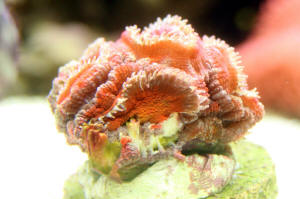 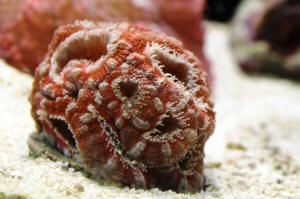 |
|
|
Injured Coral? 04/24/09
Good afternoon, I am a little worried about my "button"
coral. Although he (she?) continues to expand and contract
regularly and displays feeding tentacles at night, the flesh
seems to have receded on the one side and there is skeleton
showing. Could this be an injury from hermits, snails or our
urchin? Or is this a sign of something else?
<I could be wrong, but this does look like an injury more than
a decline in health... but I can't be sure.>
- 75 gallon display, 20 gallon sump, approx 80 lbs live rock,
2yrs old
- ammonia, nitrite, nitrate all 0
- PH approx 8.1 - 8.3
- salinity .025 <I assume you mean 1.025>
- calcium approx 380
the coral is about 18 months old, has undergone several moves in
the tank but seems happy where he is (for maybe six months). He
is not close to anyone else in the tank. Nearest neighbor is a
torch coral.
<Uh oh... this could be the culprit if within up to
6in.>
No changes in occupants or landscape since November. I have
attached a picture in hopes of some help. I rarely target feed my
corals because they are all growing and appear healthy (up to
now), but perhaps I should be.
<A little target feeding here might not hurt...>
I own Eric Borneman's coral reference book, but couldn't
really come up with a diagnosis from it. We are nowhere near a
LFS so I don't even have anyone else I could ask for an
opinion. Thanks in advance for any help you may be able to offer.
Melanie
<I don't know if it's just the angle of the photo or
what, but the way this coral is "receding" looks odd to
me. Usually, when a coral starts to recede, the rest of the coral
shows at least some signs of declining health. But your coral
looks great except for that one spot. Also, it's showing
mesenterial filaments. This could be a result of the injury, or a
way of fending off an attack. That's why I say it looks like
it was injured or is being stung (imo, again, I could be wrong--
I suppose time will tell). How this happened is better your guess
than mine... maybe a hermit or another coral.
Cheers,
Sara M.>
|
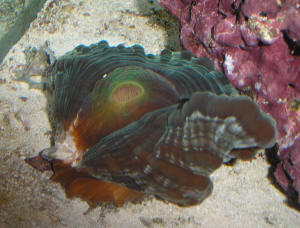 |
| What's wrong with this Scolymia? Likely
nothing... but... 4/5/07 I've had this Scolymia for
about 9 months now, and have seen somewhat of a steady decline. The
first symptom I think I noticed was a gaping of the mouth,
accompanied by mesenterial filaments inside the mouth, starting
about 6 months ago. There's also some deterioration of the
tissue surrounding the mouth. About 2 months ago or so, I saw what
I thought was a small rock lodged inside the mouth. <!?> I
got some tweezers and tried to pull the rock out, but before I
applied much pressure at all, the "rock" broke open
revealing what appeared to be sand and other debris inside.
<Likely waste> I kind of waved the loose material around, but
didn't go digging around in there to get it all out (remember,
I thought I was pulling out a pebble, not performing exploratory
surgery ). So, for the past 2 weeks or so, I started
seeing what kind of looked like a black pebble in the mouth. A
couple of days ago, I got out the trusty tweezers again and poked
at the "rock". <... no> It was actually more like a
sack of tissue, enclosing who knows what, so I stopped before
piercing the sack. Today the sack had ruptured, exposing what again
looks to be a pile of sand and debris. <Please... just leave
this be> This first picture is with the black sack intact
(apologies for the dirty glass and actinic lighting )
And this one after the sack had burst... Any ideas what the problem
is, or what I can do about it? <Am pretty sure this is
waste...> Thanks for all the help. <Mmm, not so fast... Would
like to help... but need data... Water quality tests? Your set-up,
maintenance... feeding, lighting? You have read here: http://wetwebmedia.com/mussiddisfaqs.htm and the linked
files above? You should review if so, and do, if not. Bob
Fenner> |
|
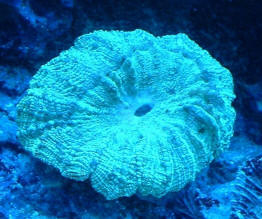 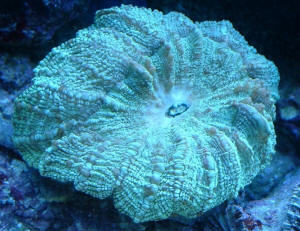
|
Scolymia - Septa tissue damage 2/24/06
Crew, <Jason> Thank you for providing all this great information
and I will try and be both detailed and brief! I have recently
purchased a Scolymia - red button which I am having some problems with.
First my parameters: 50 gal system, CPR Bak-Pak skimmer, CPR 24"
Refuquarium, activated carbon running in a small power filter, T5
lighting 1 Daylight and 1 Daylight/Actinic combo on a 12hr timer. Water
is great with 0 nitrates, 0 ammonia, 0 nitrites, PH 8.1, calcium is
400. My salinity is 1.025. Additionally I have 45lbs of live rock, and
3" of live sand. I do small weekly water changes of 5 gallons. I
have 1 hairy mushroom, 1 small button polyp, 1 large button polyp, and
a 1 week old Scolymia. I also have a Maroon clown pair, 1 three stripe
damsel, and a dwarf flame angel. Lots of snails, and some blue leg
hermits. I use Mysids, zoo-plankton, pellets, Nori, DT's,
Cyclops-Eeze, with periodic Selcon soak in a daily rotation. I try for
a good diet variety applied lightly. My tank is 7 months old, cycled
fishless for 3 months. I purchased this new addition 1 week ago at a
live fish store. The creature had been at the store for several months
and I drip acclimated it for 2 hrs after a temperature float. I did not
add the creature to my tank before testing the shipping water and
matching salinity... but I think I missed something or did a step
wrong. I placed the Scolymia mid level and in moderate water flow with
lots of room around it. <All sounds good/fine thus far> The night
of the addition the Scolymia became mucousy... probably a form of shock
and some of its septa pierced the flesh. <Very common with
just-moved Mussids> Over the next week it looked better day by day,
no mucus and the pierced tissue seemed to be recovering. Today and
yesterday it look significantly better and was inflating its
polyp/flesh. This evening however I arrived home to find that all of
the septa had pierced the flesh of its mantle and the tissue had
de-inflated. I have read in the archives that a few septa poking
through isn't uncommon (shipping transport damage) and can probably
heal. What I didn't find was the likelihood of recovery with so
much of its skeleton showing and tissue damage. An additional problem
is that the first two septa that broke through have an algae film on
them... possibly limiting its ability to heal? <The algae are indeed
a bad sign> My feeling is that this was probably caused by me during
acclimation (its killing me trying to figure out what I did wrong),
different salinity's LFS at 1.021 then acclimated to 1.025. <!
Very different... would be a good idea for you to use a
quarantine/treatment system and slowly (a 0.001 per few days) move this
animal between these differences> As I have only had this previously
healthy creature for a week it doesn't seem likely that its food or
lighting. Nothing has changed in the tank since it arrived one week
ago. So... can this creature heal with so much tissue damage? And will
the algae film on septa be a cause for concern? <Yes and yes>
Thanks so much for such a great site!! Jason <I encourage you to add
Iodine... likely as Lugol's solution here, and increase
circulation, aeration around this colony. Bob Fenner>
-Scolymia showing teeth!- Dear Bob, <Kevin here in his
stead> I have had a Scolymia for about 2 months. It feeds nicely
-almost every other day on bits of lancefish nicely soaked in Selcon
and Zoë. Originally it didn't have any 'toothy'
extensions or they were all entirely covered by the flesh. I
have noticed that now one or two protrude. <Likely from some sort of
light damage> It inflates nicely and eats avidly, if slowly -about
25 minutes- what I provide. <That's a good sign> It is in
good light, slight water motion and no nasty neighbors that would
sting. I was a bit worried that the toothy extensions through the flesh
my signal some kind of unhappiness or decay. <The toothy extensions
are it's septa which have pierced the flesh somehow, likely from
some sort of light trauma. If it does not become infected at the spot
where the flesh has torn, it should heal nicely. The only problem with
the septa sticking out is the possibility for an encroaching algae to
develop and push the tissue back further. Keep an eye out for this.>
I like it very much and it is a coral now no longer imported in the UK
<Really?! Why is this?> so I am especially keen to see it do
well. Am I worrying too much? or is there something wrong? Thanks for
all the help on your fab site. <Good luck! -Kevin> Massimo
|
|

